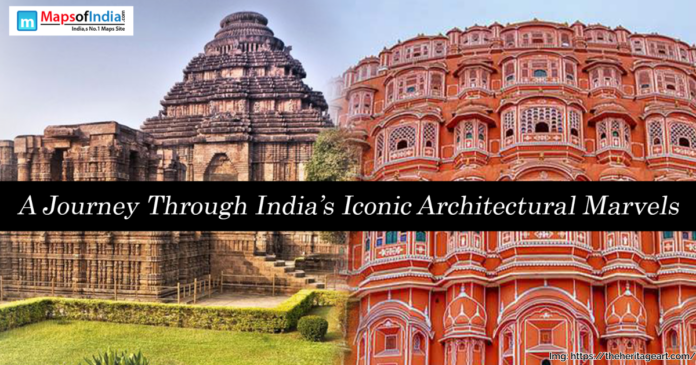Over the years, Indian architecture has been created by fusing a wide variety of civilizations, creative styles, and religious beliefs. Every location, from imposing forts and ancient temples to contemporary structures, has a unique story to tell about the history and evolving architectural styles of the subcontinent. Exploring India’s architectural treasures allows you to learn more about the country and enjoy breathtaking views.
1. Red Fort, Delhi: A Symbol of Sovereignty
Built in Old Delhi, the Red Fort or Lal Qila, shows the grandness of the Mughal era. Construction on the site was ordered by Emperor Shah Jahan in 1639, bringing Persian, Timurid and Indian architectural flair together. Red sandstone was used to build the fort, whose walls surround many palaces, gardens and halls. The fort was present when important events in India’s history took place, most notably, when the first national flag was hoisted on August 15, 1947.
2. Konark Sun Temple, Odisha: A Chariot of the Sun
Standing on the Bay of Bengal coast is the Konark Sun Temple which was built in the 13th century for the Sun God, Surya. Built like a huge chariot with 24 elegant wheels and seven horses, the temple represents the highest level of temple architecture in Odisha. Scenes of gods and the lives of ordinary people are shown all over the walls by detailed sculptures which capture the culture and community’s stories.
3. Hawa Mahal, Jaipur: The Palace of Winds
In the middle of Jaipur, the Hawa Mahal represents the beauty of Rajputana buildings. Maharaja Sawai Pratap Singh built the new palace in 1799 and its five floors are made of pink sandstone with 953 jharokhas invisibly looking out onto street celebrations. The metallic grid around the rooms guaranteed privacy and promoted fresh air which made it stand out as a classic sustainable building.
4. Mysore Palace, Karnataka: A Blend of Traditions
The Mysore Palace or as it is formally called, the Amba Vilas Palace, elegantly combines Indo-Saracenic, Dravidian and Gothic styles. Fire led to the reconstructed version of the palace in 1912, and it continues to impress with ornate ceilings, colorful stained glass and finely carved doors. With more than 97,000 bulbs used during the Dasara festival, it becomes a fascinating sight visited by millions every year.
5. Mehrangarh Fort, Jodhpur: The Citadel of the Sun
Mehrangarh Fort is built on a high hill and gives a commanding presence over the city of Jodhpur. Back in 1459, Rao Jodha established the fort, which has walls surrounding palaces, courtyards and museums. People who like history and architecture are sure to be amazed by the carvings, wide courtyards and sweeping views of Fez from above.
6. Lotus Temple, Delhi: Modern Spirituality
Many visitors admire the Lotus Temple in Delhi, which is a beautiful Baháʼí House of Worship known for its flower-like shape. Built in 1986, the temple is made from 27 marble petals that are grouped into nine sides. The temple is accessible to everyone, regardless of their belief and shows that the Baháʼí faith is based on universal brotherhood. Because of its peaceful setting and unique designs, India Gate has received much recognition and is considered a top spot in Delhi.
7. Manik Bagh Palace, Indore: A Modernist Vision
In 1930, Maharaja Yeshwant Rao Holkar II built Manik Bagh Palace which was also the first palace in India to use modern architecture. Being an example of avant-garde design, it added the country’s first central air-conditioning system, steel-framed windows with tinted glass and furniture from artists Le Corbusier and Constantin Brancusi. The Maharaja showed how progressive he was by adopting modern design and democratic beliefs, as seen by the palace’s new style.
8. Khajuraho Temples, Madhya Pradesh: Sculptural Splendor
Between 950 and 1050 AD, the Chandela dynasty constructed the Khajuraho Group of Monuments, which are renowned for their imaginative sculptures and masterful architecture. The Kandariya Mahadeva Temple is particularly noteworthy for its elaborate carvings that symbolize mythology and life. Khajuraho is remarkable because of its careful construction and unusual designs that showcase India’s old artistic traditions.
9. Rani ki Vav, Gujarat: The Subterranean Masterpiece
Rani ki Vav, which means the Queen’s Stepwell, is an impressive underground structure found in Patan, Gujarat. Queen Udayamati had this stepwell constructed in the 11th century as a tribute to her husband, and it has seven levels dug into the ground with 500 major sculptures and many finely sculpted motifs. It has ornate details and was meticulously built, proving the excellence of art during the rule of the Solanki dynasty.
10. Meenakshi Temple, Tamil Nadu: A Dravidian Marvel
The Meenakshi Amman Temple, which is in Madurai, is an important temple dedicated to the Goddess Meenakshi and Lord Sundareswarar. The main attraction at the temple complex is the massive gopurams, each featuring many brightly colored pictures of gods, goddesses, demons and mythical beings. The Hall of a Thousand Pillars and the Golden Lotus Tank represent the beautiful architecture and peaceful atmosphere found at the temple.
Conclusion
In addition to being made of brick and stone, India’s architectural treasures share the story of how civilizations flourished over the years. Every building, whether it is old or a recent creation, represents effort in art, a mix of cultures and a spiritual journey. Going to these monuments allows you to understand the nation’s amazing heritage and centuries-old traditions.




